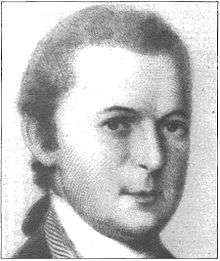Clement Biddle
Colonel Clement Biddle (May 10, 1740 – July 14, 1814) was an American Revolutionary War soldier.
Clement Biddle | |
|---|---|
 | |
| Born | May 10, 1740 Philadelphia, Pennsylvania |
| Died | July 14, 1814 (aged 74) Philadelphia, Pennsylvania |
| Allegiance | |
| Service/ | |
| Years of service | –1780 |
| Rank | |
| Battles/wars | American Revolutionary War |
| Other work | United States Marshals Service |
Life
Biddle was born May 10, 1740 in Philadelphia, Pennsylvania to John Biddle (1707–1789) and Sarah Owen (1711–1773).[1] He was the younger brother of Owen Biddle, Sr. (1737–1799). His great-grandson was Algernon Sydney Biddle.
Biddle was a part of the Society of Friends and helped organize the "Quaker Blues," a company of volunteers.[1]
Biddle's first marriage was to Mary Richardson on June 6, 1764.[2] They had one child, Francis, who died at childbirth.[2] His second marriage was to Rebekah Cornell, the daughter of Rhode Island Chief Justice Gideon Cornell.[2] They had four children: Frances (died at infancy), Thomas (born June 4, 1776), George Washington (February 21, 1779 – 1812), and Mary (born January 12, 1781).[2]
He was elected to the American Philosophical Society in 1766.[3]
During the American Revolutionary War, Biddle fought in the Battle of Princeton, the Battle of Brandywine, the Battle of Germantown and the Battle of Monmouth. He was the Commissary General at Valley Forge under George Washington, and his headquarters was at Moore Hall.[4] Biddle resigned from the Army in 1780.[1] In 1781, Biddle was made quarter-master general of the Pennsylvanian troops.
After the Revolutionary War, he was the first U.S. Marshal (1789–1793) for Pennsylvania.[5]
In the 1790 census, Biddle's jobs were "Notary, Scrivener, and Broker," which made him a rich man.[5]
Death
He died in Philadelphia on July 14, 1814,[1] and is buried at Christ Church in Philadelphia.[6]
See also
References
- Brown, John Howard; Johnson, Rossiter (1904). The twentieth century biographical dictionary of notable Americans. The Biographical Society. ISBN 1-172-21564-2.
- Glenn, Thomas Allen (1896). Merion in the Welsh tract: With sketches of the townships of Haverford and Radnor. Historical and genealogical collections concerning the Welsh barony in the province of Pennsylvania, settled by the Cymric Quakers in 1682. Genealogical Publishing Company. p. 143. ISBN 0-8063-0429-4.
- Bell, Whitfield J., and Charles Greifenstein, Jr. Patriot-Improvers: Biographical Sketches of Members of the American Philosophical Society. 3 vols. Philadelphia: American Philosophical Society, 1997, I: 292, 321, 321-26, 345.
- "National Historic Landmarks & National Register of Historic Places in Pennsylvania" (Searchable database). ARCH: Pennsylvania's Historic Architecture & Archaeology. Retrieved 2012-11-02. Note: This includes Eleanor Winsor; Harvey Freedenberg (August 1972). "National Register of Historic Places Inventory Nomination Form: Moore Hall" (PDF). Retrieved 2012-11-03.
- "The First Marshal of Pennsylvania: Clement Biddle". United States Marshals Service. Retrieved May 31, 2008.
- "Biddle, Clement (Colonel )". RootsWeb. Retrieved 8 December 2013.